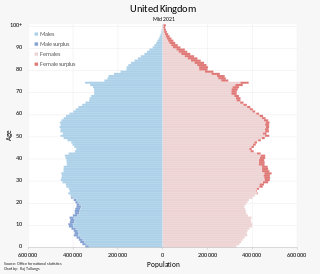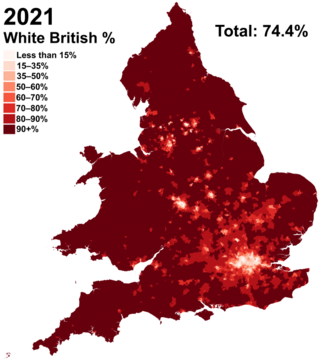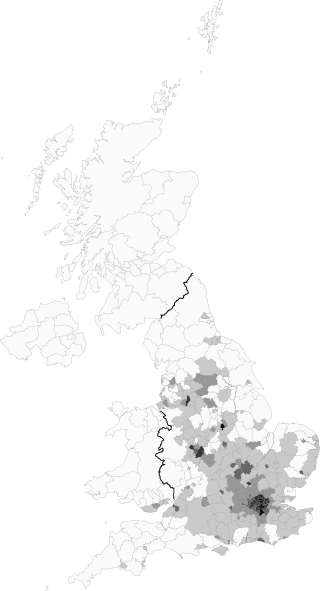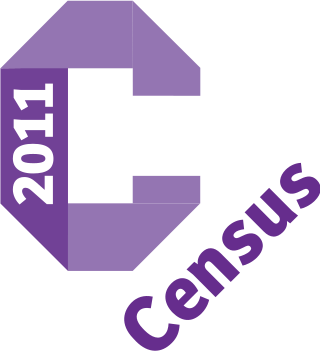
The population of the United Kingdom was estimated at almost 67.6 million people in 2022. It is the 21st most populated country in the world and has a population density of 279 people per square kilometre, with England having significantly greater density than Wales, Scotland, and Northern Ireland. Almost a third of the population lives in south east England, which is predominantly urban and suburban, with about 9 million in the capital city, London, whose population density is just over 5,200 per square kilometre.

Demographics of Wales include the numbers in population, place of birth, age, ethnicity, religion, and number of marriages in Wales.

The demography of England has since 1801 been measured by the decennial national census, and is marked by centuries of population growth and urbanization. Due to the lack of authoritative contemporary sources, estimates of the population of England for dates prior to the first census in 1801 vary considerably. The population of England at the 2021 census was about 56,489,800.
The foreign-born population of the United Kingdom includes immigrants from a wide range of countries who are resident in the United Kingdom. In the period January to December 2016, there were groups from 22 foreign countries that were estimated to consist of at least 100,000 individuals residing in the UK.

The demography of Scotland includes all aspects of population, past and present, in the area that is now Scotland. Scotland had a population of 5,463,300 in 2019. The population growth rate in 2011 was estimated as 0.6% per annum according to the 2011 GROS Annual Review.

Ion Rațiu was a Romanian lawyer, diplomat, journalist, businessman, writer, and politician. In addition, he was the official presidential candidate of the Christian Democratic National Peasants' Party (PNȚCD) in the 1990 Romanian presidential election in which he subsequently finished third, behind the neo-communist Ion Iliescu of the National Salvation Front (FSN) and Radu Câmpeanu of the National Liberal Party (PNL), with only 617,007 votes.

White British is an ethnicity classification used for the native white population identifying as English, Scottish, Welsh, Cornish, Northern Irish, or British in the United Kingdom Census. In the 2011 census, the White British population was 49,997,686, 81.5% of Great Britain's total population. For the United Kingdom entirely, due to different reporting measures within Northern Ireland which includes all those who identified as British with those who identified as Irish, an amalgamated total of 52,320,080 including those who identified as White Irish in Great Britain is given making up 82.8% of the population.
Australians in the United Kingdom, or Australian Britons, include Australians who have become residents or citizens of the United Kingdom. The largest segment of Australia's diaspora of 1 million resides in the United Kingdom.

French migration to the United Kingdom is a phenomenon that has occurred at various points in history. The Norman Conquest of England by William the Conqueror in 1066 resulted in the arrival of Normans, while in the 16th and 17th centuries Protestant Huguenots fled religious persecution to East London. Other waves are associated with monasticism, particularly post-conquest Benedictines and Cistercians, aristocracy fleeing the French Revolution, expulsion of religious orders by Third Republic France, and current expats.

Mixed is an ethnic group category that was first introduced by the United Kingdom's Office for National Statistics for the 2001 Census. Colloquially, it refers to British citizens or residents whose parents are of two or more races or ethnic backgrounds. The Mixed or Multiple ethnic group in England and Wales numbered 1.7 million in the 2021 census, 2.9% of the population.

Spaniards in the United Kingdom are people of Spanish descent resident in Britain. They may be British citizens or non-citizen immigrants.
Ukrainians in the United Kingdom consist mainly of British citizens of Ukrainian descent.

The term Other White, or White Other, is a classification of ethnicity in the United Kingdom, used in documents such as the 2021 United Kingdom Census, to describe people who identify as white persons who are not of the English, Welsh, Scottish, Roma, Irish or Irish Traveller ethnic groupings. In Scotland, the term Other White is also used to refer collectively to those not of Scottish or Other British ethnicity, in which case it also includes those of a Gypsy, Roma, Irish or Irish Traveller background.
British Afghans are British citizens and non-citizen residents born in or with ancestors from, Afghanistan, part of worldwide Afghan diaspora. The Office for National Statistics (ONS) estimates that there were 79,000 people born in Afghanistan living in the UK in 2019.

According to ONS estimates in 2019 there were 76,000 Nepalese-born people in the United Kingdom.

A census of the population of the United Kingdom is taken every ten years. The 2011 census was held in all counties of the UK on 27 March 2011. It was the first UK census which could be completed online via the Internet. The Office for National Statistics (ONS) is responsible for the census in England and Wales, the General Register Office for Scotland (GROS) is responsible for the census in Scotland, and the Northern Ireland Statistics and Research Agency (NISRA) is responsible for the census in Northern Ireland.
Congolese in the United Kingdom consist of immigrants from the Democratic Republic of the Congo (DRC) living in the United Kingdom as well as their British-born descendants. The demonym Congolese can also refer to people from the Republic of Congo, of whom there are fewer living in the UK.
Eritreans in the United Kingdom or Eritrean Britons are an ethnic group that consist of Eritrean immigrants to the United Kingdom as well as their descendants.
Albanians in the United Kingdom include immigrants from Albania and ethnic Albanians from Kosovo. According to estimates from the Office for National Statistics, there were 47,000 Albanian-born residents of the United Kingdom in 2019.

The Wrexham Built-up area is an area of land defined by the United Kingdom Office for National Statistics (ONS) for population monitoring purposes. It is an urban conurbation fully within Wrexham County Borough and consists of the urban area centred on the city of Wrexham. Until the 2021 census, it also included the historically industrial settlements to the west including Gwersyllt, Rhostyllen, Brymbo, Bradley and New Broughton.





















